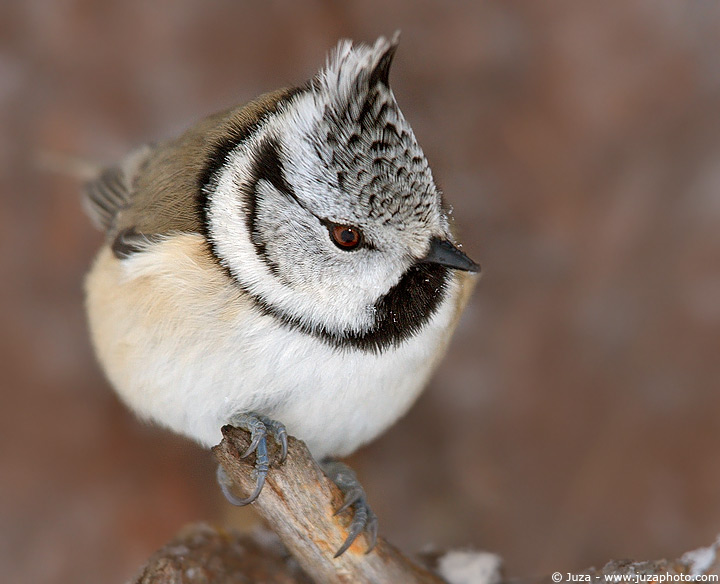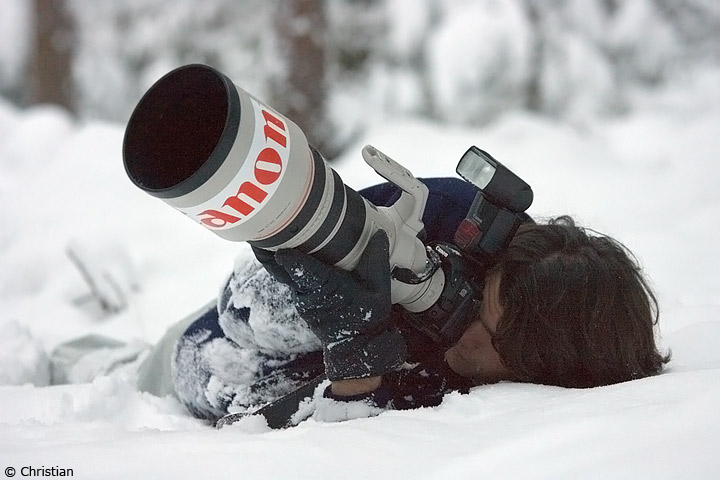JuzaPhoto utilizza cookies tecnici e cookies di terze parti per ottimizzare la navigazione e per rendere possibile il funzionamento della maggior parte delle pagine; ad esempio, è necessario l'utilizzo dei cookie per registarsi e fare il login (
maggiori informazioni).
Proseguendo nella navigazione confermi di aver letto e accettato i Termini di utilizzo e Privacy e preso visione delle opzioni per la gestione dei cookie.Puoi gestire in qualsiasi momento le tue preferenze cookie dalla pagina
Preferenze Cookie, raggiugibile da qualsiasi pagina del sito tramite il link a fondo pagina, o direttamente tramite da qui:
Crested Tit in winter
Crested Tit in winter, testo e foto by
Juza. Pubblicato il 07 Giugno 2012; 0 risposte, 3790 visite.

Canon EOS 20D, Canon EF 400mm f/2.8 L IS USM, Canon 1.4x TC, 1/320 f/5.6, iso 800, handheld. Engadin, Switzerland.
"Snow? What snow? There is no snow!" Ciro said. So, we didn't expect to find much snow; Ciro had visited the Roseg Valley just one week ago, and the temperature was still relatively warm (between 0 and -4 celsius degrees...last year, in the same period the temperatuer was around -20°). Instead, few kilometers after the Swiss border we were caught in a snowstorm. Initially it was a beautiful view, but after few minutes the road was covered by snow, and our car had serious problems to go ahead...in some steep curves the wheels slipped on snow and we were almost still!
Anyway, we managed to arrive to Pontresina. The first day (saturday) was not great; we had arrived too late and the light was pretty dim. Sunday, instead, was more lucky: we arrived in the wood in early morning and, as soon as we threw few seeds and peanuts on the snow, some tits and other birds arrived at few meters from us. My friend Christian photographed with the 1DN and 600 f/4, while me and Daniela used the 600 f/4 and the 400 f/2.8 + 1.4x TC. Since there was not much light and even aty ISO 800 the shutter speed was quite slow, I decided to use the Canon 580EX flash to get a little more light...I'm not a big fan of flash (the 99% of my photos are taken exclusively in natural light), but sometimes it really helps, and I'm trying to learn to use it well ;-)
The depth of field was a big problem with these subject. The tits are pretty small and it is necessary an aperture of f/8 or f/11 to get the entire bird in focus, but the light was way too dim to stop down so much, and we had to photograph with relatively wide apertures. In these situations, the focus must be on the eye of the subject - if the eye is sharp, the photo works, even if the entire body in not in sharp focus. I used AI Serve and MFPS with center AF area and I choose to handhold the lens to have more freedom of movement: these birds are very active! I'm impressed by the image stabilizator; of course some shots are blurred, but many photos are sharp, I've got some razor sharp photos hendholding the 600 f/4 at 1/100s!

Myself photographing in the snow with 400 2.8 L IS, 1.4x TC, Canon 20D and 580EX. Photo courtesy by Christian. The 400 f/2.8, as the 500 and the 600, has a non-removable, rotating tripod collar: when I handhold the lens, I rotate it upside-down, so it is not an "obstacle" during handholding and it allows to handle the lens during resting. There were nearly 30 centimeters of snow, and sometimes the snow fell from the three, but the weather sealing protected the lenses from any infiltration of water or snow. The 20D and the flash are not weather sealed, but with a little of care there is no risk using them in snow or rain.
I've set the flash on -0.3 (with ETTL metering) and the camera on AV mode, aperture f/5.6 and ISO 800. With these settings, the exposure is a mix of natural light and flash light, but the natural light is still the main source of light for the exposure. In my opinion, the flash must not be evident in the photo - to be successful, the image should look as if it was taken just with the natural light...I don't like "overflashed" images, where the flash creates harsh shadows.
This crested tit landed really close to me...I'm glad that I was using the 400: the bird was at nearly four meters, and I was able to take the photo since the 400 2.8 has a minimum focussing distance of three meters, while the 600 has a minimum of 5.5 meters. The tit had a funny "puffed" look that, in my opinion, makes this photo.
Risposte e commenti
Che cosa ne pensi di questo articolo?
Vuoi dire la tua, fare domande all'autore o semplicemente fare i complimenti per un articolo che ti ha colpito particolarmente? Per partecipare iscriviti a JuzaPhoto, è semplice e gratuito!
Non solo: iscrivendoti potrai creare una tua pagina personale, pubblicare foto, ricevere commenti, partecipare alle discussioni e sfruttare tutte le funzionalità di JuzaPhoto. Con oltre 256000 iscritti, c'è spazio per tutti, dal principiante al professionista.



 JuzaPhoto contiene link affiliati Amazon ed Ebay e riceve una commissione in caso di acquisto attraverso link affiliati.
JuzaPhoto contiene link affiliati Amazon ed Ebay e riceve una commissione in caso di acquisto attraverso link affiliati.